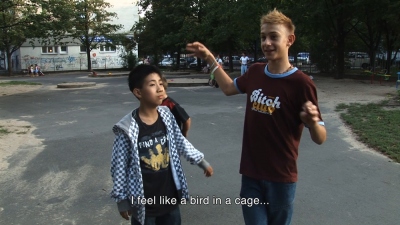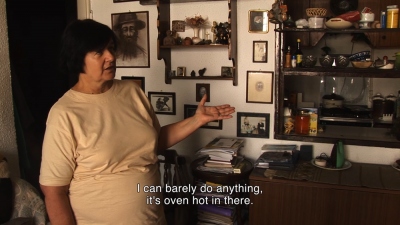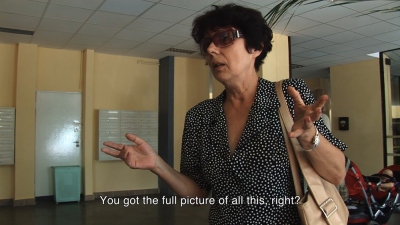Heidrun Holzfeind
Za Żelazną Bramą [Behind the Iron Gate]
In 2007, Heidrun Holzfeind came to Warsaw and moved to Za Żelazną Bramą housing estate. She was fascinated by the architecture and contemporary everyday life of the estate built in 1965–1972 on the ruins of the so-called Small Ghetto. In the 1970s, the modernist blocks of flats were considered a symbol of socialist prosperity and rational construction principles. Currently, they are seen as poor standard of housing, an unpleasant reminder of the communist era, and are home to Vietnamese and Jewish communities gradually trying to assimilate in Warsaw. The artist recorded numerous conversations with the residents of the estate and employees of service points located there; she filmed scenes in staircases, in apartments, shops, and their surroundings – in parking lots, lawns, and playgrounds. She sought out existing films and series from the 1970s featuring the estate. In the documentary, its complicated history is intertwined with the everyday life and rituals of the inhabitants. The artist also captured discussions about the changes in social life and the adaptation of modernist architecture to contemporary needs of inhabitants. A great advantage of the film is reaching deep into the history of the area and uncovering it successive layers. The artist has recorded the reality of living in a high rise in the centre of the capital in a unique way, simultaneously avoiding journalistic bias, aestheticism, or sentimentality.
Heidrun Holzfeind is an artists and documentary filmmaker born in Austria, following 15 years in New York she has returned to Vienna. She currently lives in Sweden, where she teaches photography at the Umeå Art Academy. She studied art at the Academy of Fine Arts in Vienna and at Cooper Union in New York. Holzfeind creates works on the intersection photography, film, sculpture, architecture, and urban planning. She is particularly interested in the mutual relations between society and individual identity, private histories and contemporary political narratives, as well as the interactions between architecture and everyday life.


